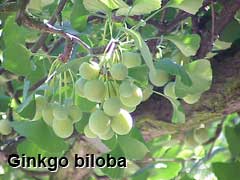Abnormal Development - Herbal Drugs: Difference between revisions
| Line 44: | Line 44: | ||
==Feverfew== | ==Feverfew== | ||
[[File:Feverfew 02.jpg| | [[File:Feverfew 02.jpg|240px]] | ||
Feverfew (''Tanacetum parthenium'', ''Chrysanthemum parthenium'') is a short bush with daisy-like flowers. This herb may cause the uterus to contract, increasing the risk of miscarriage or premature delivery. | Feverfew (''Tanacetum parthenium'', ''Chrysanthemum parthenium'') is a short bush with daisy-like flowers. This herb may cause the uterus to contract, increasing the risk of miscarriage or premature delivery. | ||
Revision as of 17:59, 3 December 2010
Introduction
This page introduces the possible effects of maternal use of herbal drugs (therapeutic chemicals/agents) on development. In some cases these drugs are "prescribed" to treat pre-existing or pregnancy related maternal medical conditions. In all cases, a discussion with a medical practioner should be had prior to any reproductive decision.
The following herbal drugs have been used for a number of different maternal conditions: Ginkgo Biloba, Kava (Piper methysticum), St. John's wort (Hypericum perforatum), Tian Ma (Gastrodia elata), Valerian (Valeriana officinalis). In some cases very little is known about the potential teratogenic effects of these drugs. Furthermore, care should be made when comparing evaluation of drugs in different species.[1]
The National Center Complementary and Alternative Medicine (USA) provides excellent summary information sheets on many of the commonly used herbal treatments, though many of these information sheets do not include information about herbal drug use during pregnancy. This current page gives some examples of herbs which may impact on development, for further information see NIH - Herbs at a Glance PDF.
| Educational Use Only - Embryology is an educational resource for learning concepts in embryological development, no clinical information is provided and content should not be used for any other purpose. |
Some Recent Findings
|
Black Cohosh
Black cohosh (Actaea racemosa, Cimicifuga racemosa, black snakeroot, macrotys, bugbane, bugwort, rattleroot, rattleweed) is a member of the buttercup family and is native to North America. It is not clear if black cohosh is safe for women with a liver disorder, hormone-sensitive conditions, or for pregnant women or nursing mothers.
Black cohosh should not be confused with blue cohosh (Caulophyllum thalictroides).
Cat’s Claw
Cat’s Claw (Uncaria tomentosa, Uncaria guianensis) should be avoided because of its past use for preventing and aborting pregnancy.
Chasteberry
Chasteberry (Vitex agnus-castus, chaste-tree berry, vitex, monk’s pepper) is the fruit of the chaste tree. This herb may affect certain hormone levels, women who are pregnant or taking birth control pills or who have a hormone-sensitive condition (such as breast cancer) should not use chasteberry.
Ephedra
Ephedra (Ephedra sinica) is an evergreen shrub-like plant, the principal active ingredient ephedrine can powerfully stimulate the nervous system and heart. In 2004, the FDA banned the U.S. sale of dietary supplements containing ephedra.
Fenugreek
Fenugreek (Trigonella foenum-graecum) is a legume plant who's seeds are commonly as a food spice. It was used historically for inducing childbirth.
Feverfew
Feverfew (Tanacetum parthenium, Chrysanthemum parthenium) is a short bush with daisy-like flowers. This herb may cause the uterus to contract, increasing the risk of miscarriage or premature delivery.
Ginkgo Biloba
Ginkgo leaf extract has been used to treat a variety of ailments and conditions, including asthma, bronchitis, fatigue, and tinnitus (ringing or roaring sounds in the ears).
Extracts are usually taken from the ginkgo leaf and are used to make tablets, capsules, or teas. Occasionally, ginkgo extracts are used in skin products.
Goldenseal
Goldenseal (Hydrastis canadensis, orange-root, yellow-root) is a perennial herb in the buttercup family, it contains the chemical berberine that can cause or worsen jaundice in newborns and may lead to a life-threatening problem called kernicterus. Kernicterus is a form of brain damage caused by excessive jaundice.
Licorice Root
Licorice (Glycyrrhiza glabra, Glycyrrhiza uralensis, gan zao (Chinese licorice)) contains a compound called glycyrrhizin (or glycyrrhizic acid) and consuming large amounts of licorice as food may alter cortisol and related steroid drug levels, as well as increase the risk of preterm labor.
Red Clover
Red clover (Trifolium pratense) is a legume and contains phytoestrogens, compounds that are similar to the female hormone estrogen.
St. John's Wort
St. John's Wort (Hypericum perforatum, hypericum, Klamath weed, goatweed) a plant with yellow flowers used to prepare teas, this herb interacts with many medications in ways that can interfere with their intended effects.
HSTAT St. John's Wort | Appendix II: Side Effects, Adverse Effects, Precautions, and Warnings "The safety of using hypericum during pregnancy or lactation has not been proven so it should be avoided." "St. John's wort induces the CYP 450 3A4 metabolic pathway which is also used by many prescription drugs used to prevent conditions (transplant rejection or pregnancy oral contraceptives), health care providers should alert patients about these potential drug interactions."
Yohimbe
Yohimbe (Pausinystalia yohimbe ) is derived from the bark of a tall evergreen tree native to western Africa. Women who are pregnant or breastfeeding should not take yohimbe.
References
- ↑ <pubmed>3104022</pubmed>| PMC1474298
- ↑ <pubmed>20437472</pubmed>
Reviews
- Saunders EJ, Saunders JA. Drug therapy in pregnancy: the lessons of diethylstilbestrol, thalidomide, and bendectin. Health Care Women Int. 1990;11(4):423-32.
Articles
- McBride WG. Prescription drugs in the first trimester and congenital malformations. Aust N Z J Obstet Gynaecol. 1992 Nov;32(4):386.
Search Pubmed
June 2010 "herbal drugs in pregnancy" All (395) Review (50) Free Full Text (30)
Search Pubmed: herbal drugs in pregnancy | herbal drug teratogen
External Links
- National Center Complementary and Alternative Medicine (USA)
- NIH - Herbs at a Glance PDF
- United Nations International Drug Control Programme
- Australian Drug Foundation (ADF)
- Centre for Education and Information on Drugs and Alcohol (CEIDA) (Australia)
- Child Health and Safety (Australia)
- NIDA (USA)- Consequences of Prenatal Drug Exposure
- Australian Medicines Handbook (no electronic version yet)
- Australian Congenital Anomalies Monitoring System (ACAMS)
- Australian Institute of Health and Welfare (AIHW)
Glossary Links
- Glossary: A | B | C | D | E | F | G | H | I | J | K | L | M | N | O | P | Q | R | S | T | U | V | W | X | Y | Z | Numbers | Symbols | Term Link
Cite this page: Hill, M.A. (2024, May 3) Embryology Abnormal Development - Herbal Drugs. Retrieved from https://embryology.med.unsw.edu.au/embryology/index.php/Abnormal_Development_-_Herbal_Drugs
- © Dr Mark Hill 2024, UNSW Embryology ISBN: 978 0 7334 2609 4 - UNSW CRICOS Provider Code No. 00098G


